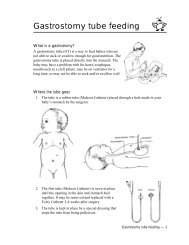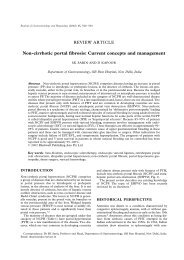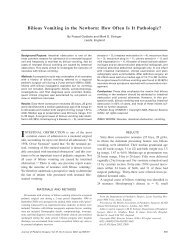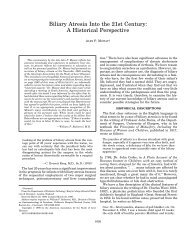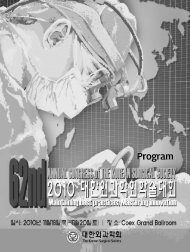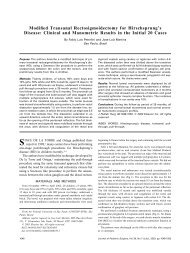Langerhans' cell histiocytosis as a cause of periportal abnormal ...
Langerhans' cell histiocytosis as a cause of periportal abnormal ...
Langerhans' cell histiocytosis as a cause of periportal abnormal ...
You also want an ePaper? Increase the reach of your titles
YUMPU automatically turns print PDFs into web optimized ePapers that Google loves.
376 M. Kim et al.: MRI <strong>of</strong> hepatic Langerhans’ <strong>cell</strong> <strong>histiocytosis</strong>or nodular. Some hypoechoic nodules looked like targets.We suspect that <strong>periportal</strong> hypoechogenicity maybe attributed to the infiltration <strong>of</strong> histiocytes and inflammatory<strong>cell</strong>s b<strong>as</strong>ed on our biopsy result, whichaccorded with the reports <strong>of</strong> Hara et al. [4] and Muwakkitet al. [5].MRI findings <strong>of</strong> the liver in LCH have been notedin two c<strong>as</strong>e reports [6, 8]. These c<strong>as</strong>es presented <strong>as</strong>m<strong>as</strong>s lesions <strong>of</strong> the liver, which had imaging characteristics<strong>of</strong> <strong>periportal</strong> fibrosis and focal fatty infiltration.In the present c<strong>as</strong>es, MRI showed PASI ratherthan a focal m<strong>as</strong>s. Matsui et al. [12] described <strong>periportal</strong><strong>abnormal</strong> intensity on MRI from patients withcholangitis, obstructive jaundice that w<strong>as</strong> due toedema, inflammatory <strong>cell</strong> infiltration, and proliferation<strong>of</strong> bile ductules. On each T1-WI and T2-WI, signalintensity <strong>of</strong> <strong>periportal</strong> lesions in our patients w<strong>as</strong> lowerand higher than that <strong>of</strong> surrounding hepatic parenchyma,respectively. Signal intensity <strong>of</strong> these lesionsw<strong>as</strong> incre<strong>as</strong>ed on contr<strong>as</strong>t-enhanced T1-WI with fatsuppression. PASI extended diffusely from the centrallarge portal tracts to peripheral small ones in patients 1and 2, who eventually developed hepatic dysfunction.In addition to the extensive PASI, intrahepatic bile ductdilatation and nodularity due to secondary biliary cirrhosiswere noted in patient 2. This finding is in contr<strong>as</strong>tto PASI confined to the central large portal tract inpatient 3 who h<strong>as</strong> not yet developed hepatic dysfunction.Pathologic examination <strong>of</strong> this patient showedbile ductular proliferation and periductal histiocyticand lymphocytic infiltration. On follow-up MRI obtained2 years later, PASI w<strong>as</strong> not seen in all sequences<strong>as</strong> compared with that <strong>of</strong> the initial study. We considerthat MRI <strong>of</strong> the liver in children with disseminatedLCH may be different according to the pathologicalchange, ranging from triaditis to <strong>periportal</strong> fibrosis andbiliary cirrhosis.In summary, we could find PASI <strong>as</strong> a common featureon initial MRI <strong>of</strong> three children with disseminated LCH.As already known, PASI itself is nonspecific. However,in conjunction with clinical and laboratory data, MRI canbe valuable in the estimation <strong>of</strong> morphologic change <strong>of</strong>the liver in children.ReferencesFig. 3. C<strong>as</strong>e 3. A T1-weighted image (550/17) with fat suppressionshows <strong>periportal</strong> low signal intensity that is confined to the central portaltracts. B Periportal enhancement is clearly seen on contr<strong>as</strong>t-enhancedT1-weighted image (600/11) with fat suppression. C T1-weighted image(500/8) obtained 2 years later shows no <strong>periportal</strong> low signal intensity.1. Heyn RM, Hamoudi A, Newton WA. Pretreatment liver biopsy in20 children with <strong>histiocytosis</strong> X: a clinicopathologic correlation.Med Pediatr Oncol 1990;18:110–1182. Squires RH, Weinberg AG, Zweiner RJ, et al. Langerhans’ <strong>cell</strong><strong>histiocytosis</strong> presenting with hepatic dysfunction. J Pediatr G<strong>as</strong>troenterolNutr 1993;16:190–1933. Leblanc A, Hadchouel M, Jehan P, et al. Obstructive jaundice inchildren with <strong>histiocytosis</strong> X. G<strong>as</strong>troenterology 1981;80:134–1394. Hara T, Mizuno Y, Ishii E, et al. Histiocytosis X presenting <strong>as</strong>multiple intrahepatic nodules. Acta Haematol Jpn 1988;51:1059–1062




